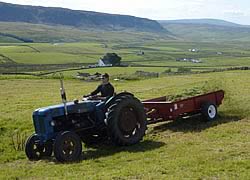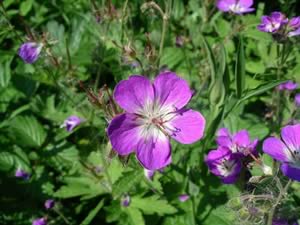 |
|||||||||
|
|||||||||||||||||||
|
|
Hay Time Project Reports Seed Spreading Success A seven-year project run by the North Pennines Area of Outstanding Natural Beauty (AONB) Partnership to restore rare upland hay meadows is really reaping rewards, new findings reveal.
Important plants such as yellow rattle, common bent, eyebright, wood crane’s-bill, ragged robin and lesser trefoil are making a comeback in the North Pennines meadows thanks to the AONB Partnership’s Hay Time project, funded by the County Durham Environment Trust and the Heritage Lottery Fund (HLF). Working with farmers across the North Pennines, seed has been harvested from hay meadows rich in wildflowers and then spread on nearby meadows which have lost their special plants. Now half a decade’s hard work is starting to have great results, as recent research shows. An interim analysis of botanical survey data gathered so far indicates that this approach to hay meadow restoration is working and that plant species typical of the special hay meadows found in the North Pennines can be reintroduced using the AONB Partnership’s Hay Time approach. Within the UK, species-rich hay meadows are a rare habitat, having declined by more than 97% over the past 60 years as a result of progressive agricultural intensification. The meadows found in the North Pennines are a special type, characteristic of the harsh conditions typical of hilly and mountainous regions across Europe. These ‘upland’ or ‘mountain hay meadows’ are now a very rare habitat with little more than 900ha thought to remain in the UK. With 350ha of these upland hay meadows, the North Pennines AONB is an important place for this special habitat. From a botanical perspective, the importance of upland hay meadows lies in the rich diversity of wild plants that grow in them. The best meadows can support up to 120 different species of flowering plant. Many of these are characteristic of northern latitudes and are found close to their southern boundary in the North Pennines, species like wood crane’s-bill, melancholy thistle and globeflower, for example. Since May 2006, the North Pennines AONB Partnership through its Hay Time project has been working closely with farmers and colleagues from Natural England to restore meadows that have lost their characteristic plant species. Ruth Starr-Keddle, the Partnership’s Hay Time Project Officer, said: “Using special machinery, we harvest either the seed-bearing top of the hay crop or the entire crop and then spread it as ‘green hay’ on a nearby meadow. Not only should this approach enable the effective transfer of seeds, a process that would take decades to occur naturally, but it should ensure that the unique genetic integrity of these meadows is maintained. Since 2006 we have spread seed on 135ha of meadows across the AONB.” Thirty of the meadows where seed has been spread in recent years have been monitored either by AONB Partnership staff or experienced volunteer botanists since seed addition. Ruth said: “There are a number of species which are particularly characteristic of upland hay meadows which we hope to see becoming established after the addition of seed. We refer to these as positive indicator species. During meadow surveys, these species are given a score between 1 and 4, the more special the species, the higher the score.”
Ruth said: “Plants that we have found to be very successful at establishing following seed addition include yellow rattle, common bent, eyebright, wood crane’s-bill, ragged robin and lesser trefoil. Monitoring all the sites where we have spread seed will remain a high priority during the final two summers of the project after which we will produce detailed results of our findings. “These interim results serve to give us confidence that the approach we are taking works and that over the coming years we can expect to see more and more plants establishing in meadows where seed has been spread.”
|
||||||||||||||||||

|
|
||||||||||||||||||
| home | agri-services | pedigree
pen | news | dairy | beef | machinery BPS | property | organisations | site map |
|||||||||||||||||||



